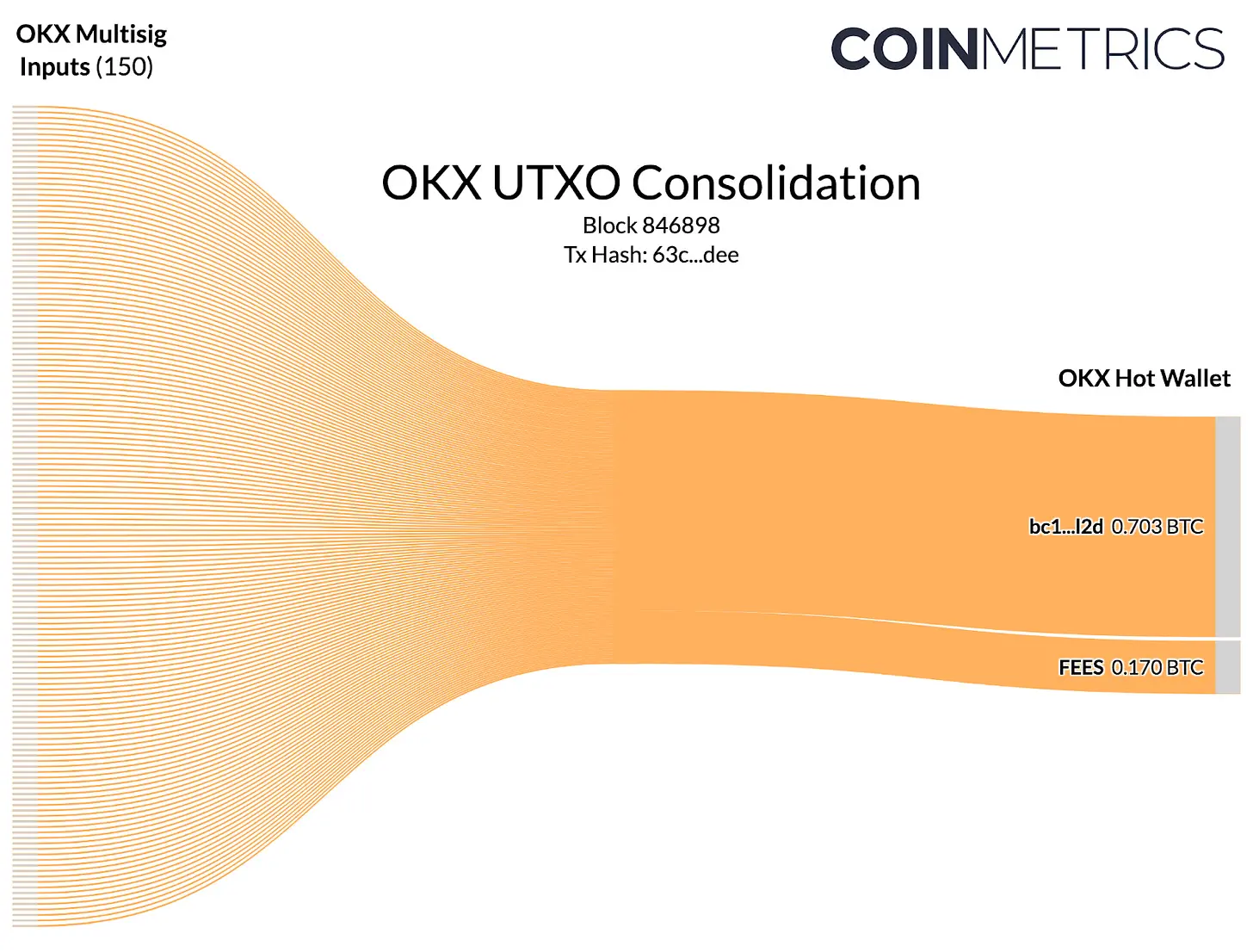Overview of the Status and Data of Cryptocurrency Mining in Q2 2024
Original Title: State of the Network's Q2 2024 Mining Data Special
Original Author: Parker Merritt
Original Source: substack
Original Compilation: Eason, Mars Finance
Key Points:
- After the halving, Bitcoin's hash rate (30-day moving average) has dropped 7% from its all-time high of 626 EH/s to 580 EH/s.
- OKX's large-scale UTXO consolidation provided a brief boost to transaction fee revenue, with miners earning $38 million in fees over three days.
- Toronto-based mining company Bitfarms has made remarkable progress in mining efficiency, reducing incremental energy consumption from 35 J/TH to 27 J/TH by 2024.
- During the peak of the 2021 bull market, Antminer S19 traded at $100 / TH, while its current trading price on the secondary market has dropped to $2.5 / TH.
Introduction
This week's network status report reviews the landscape of Bitcoin mining, continuing our quarterly update series on proof-of-work stakeholders. Since the Bitcoin halving in April, mining profitability has faced pressure due to stagnant BTC prices and a sluggish fee market, although brief on-chain congestion provided some revenue relief. Many operators are shifting from pure mining to diversification, rebranding themselves as general infrastructure providers in an attempt to secure hosting contracts for high-energy AI applications. Meanwhile, the momentum of chip efficiency improvements remains strong, forcing miners to consider whether to continue using aging ASIC hardware or undertake a complete fleet upgrade. In this report, we will delve into each of these factors, investigating the health of the mining industry beyond BTC price performance.
Consolidation Operations
At first glance, Q2 2024 has been a relatively profitable period for Bitcoin miners. This quarter ranks fifth in total dollar revenue among the 18 quarters since January 2020, with miners bringing in $3.77 billion between block subsidies and transaction fees. Of course, due to the halving, these earnings are front-loaded, with nearly half of this quarter's revenue coming from April alone. After the Bitcoin block reward dropped from 6.25 BTC to 3.125 BTC on April 20 and the hype around "Rune" tokens gradually faded in the following weeks, May and June proved to be more challenging months for miners. Consequently, Bitcoin's hash rate shows signs of miner capitulation—at 580 EH/s, the 30-day moving average of the hash rate has decreased by 7% from the all-time high of 626 EH/s.

Source: Coin Metrics Network Data Pro
Despite the overall revenue momentum weakening, an unexpected increase in on-chain traffic still provided miners with some breathing room. At the beginning of June, Bitcoin's mempool was overwhelmed by a surge of high-fee transactions, with average hourly transaction fees reaching as high as $945 by noon on June 7. The congestion significantly increased mining revenue, with the hash price (daily dollar revenue per TH/s) soaring to $0.09, with fees accounting for over 42% of revenue.

Source: Coin Metrics Network Data Pro
While the spike in fees is typically attributed to token protocols like Ordinals & Runes, the latest increase in mining revenue was driven by the internal operations of a single centralized exchange. OKX (the fourth largest exchange by BTC spot trading volume) conducted a series of large-scale "UTXO consolidations," cleaning up its books by merging scattered Bitcoin portions into larger, more compact denominations. Since BTC transactions are priced based on the block space they consume, transactions involving many UTXOs incur higher transfer costs, while "consolidated" UTXOs unlock payments with lighter, more cost-effective on-chain space.

Source: Coin Metrics ATLAS
The UTXO consolidation process is akin to pouring a jar of loose change into a coin counting booth to exchange it for a $20 bill. However, like Coinstar, this service comes at a cost. While daily fee revenue typically hovers around $1-2 million, miners earned nearly $38 million within three days following OKX's UTXO consolidation. In hindsight, OKX could have executed the accounting cleanup more efficiently, paying a hefty premium for quick settlements—but faced with quiet transaction queues and record-low hash prices, miners certainly have no complaints.
On Infrastructure
In the weeks following the Bitcoin halving, most publicly listed mining companies have consolidated alongside BTC. The stock prices of the three major mining companies—Marathon Digital (MARA), CleanSpark (CLSK), and Riot Platforms (RIOT)—have struggled to outperform BTC in Q2, with only Marathon barely achieving a relatively small return. So far, the biggest winners have been the underdogs in the Bitcoin mining race, with Core Scientific (CORZ), Iris Energy (IREN), and TeraWulf (WULF) outperforming their competitors by double digits. It is no coincidence that these companies have heavily capitalized on the AI hype, positioning themselves as energy and infrastructure providers for broader computing applications.
In June, Core Scientific signed a series of multi-billion dollar contracts with "AI super scaler" CoreWeave, agreeing to use hundreds of megawatts of power capacity to host the company's high-performance computing (HPC) hardware. Shortly thereafter, Core Scientific received an "unsolicited proposal" from CoreWeave to acquire its entire business, which was rejected on the grounds of Core's "growth prospects" and "value creation potential." IREN and WULF also emphasized their unique positioning in hosting HPC infrastructure, making them attractive partners (and potential acquisition targets) for AI-focused enterprises increasingly constrained by energy.

Source: Coin Metrics Reference Rates and Yahoo Finance
For other miners, price movements have primarily been driven by mergers and acquisitions within the industry. Although micro-miner GRIID Infrastructure (GRDI) has lagged behind its peers since going public this year, CleanSpark announced in June that it would acquire the company, claiming the deal would increase its power capacity by 400 megawatts within two years. In May, Riot Platforms disclosed its 9.25% stake in Bitfarms (BITF), a slightly smaller miner currently facing corporate governance issues. Riot offered approximately $950 million for a wholesale acquisition of Bitfarms, claiming the acquisition would create "the world's largest publicly traded Bitcoin miner" by the end of the year. Bitfarms immediately rejected the proposal and implemented a "poison pill" plan to thwart Riot's hostile takeover, aimed at diluting entities seeking acquisition in the public market.
Riot's motivation to acquire Bitfarms can be attributed to several factors, but one notable aspect is its significant efficiency improvement. Historically, Bitfarms has utilized low-cost hydroelectric power and older generation ASICs rather than upgrading to cutting-edge hardware. This has led to their lagging behind competitors in metrics such as fleet efficiency—measured in "joules per terahash" (J/TH)—representing the incremental energy consumed to produce hash rates. However, Bitfarms has recently implemented a comprehensive fleet upgrade, purchasing Antminer T21s with a capacity of 16 EH/s (19 J/TH). By 2024, Bitfarms' average fleet efficiency will rise from 35 J/TH to 27 J/TH, surpassing Riot's stagnant efficiency of 27.7 J/TH.

Source: Coin Metrics MINE-MATCHand Public Disclosures
Bitfarms is not the only company to achieve significant improvements in average mining efficiency. Over the past six months, Iris Energy has reduced its average energy consumption by 15% to 25 J/TH, while TeraWulf's efficiency has increased by 11% to 24.6 J/TH. Core Scientific has emerged from Chapter 11 bankruptcy proceedings and currently leads with an efficiency of 24.23 J/TH, beating the current efficiency leader Marathon Digital, which has an efficiency of 24.5 J/TH. As the competition to streamline and optimize operations narrows down to decimal points, miners are now looking towards the next generation of ASICs in hopes of seizing the next opportunity to outpace their competitors.
The ASIC Era
After more than a decade of chip manufacturing innovation, the efficiency of Bitcoin mining ASICs has reached unprecedented heights. The first commercial ASIC—Avalon 1 by Canaan Creative—was launched in January 2013, with a hash rate of just 0.06 TH/s. With a power consumption of 620 watts, it had an efficiency of 10,333 J/TH. At the time, this was a massive leap in original hash rate output, with the entire network hash rate at just 22 TH/s. Shortly after the release of Avalon 1, competing manufacturers entered the market, and continuous technological advancements increased hash rates by 14,000 times within two years.
Since then, the rate of efficiency improvement has gradually diminished from the early exponential growth, but manufacturers are still actively reducing the energy required to produce incremental units of hash rate. In June, Bitmain released its latest series of Antminer S21 XP models, with the water-cooled version reaching speeds of 473 TH/s and an efficiency of 12 J/TH. Although Bitmain remains a giant in the industry, upstarts like Bitdeer, led by former Bitmain CEO Jihan Wu, have announced ambitious plans to produce ASICs with 5 J/TH before Q2 2025.

Source: Coin Metrics Network Data Proand Bitcoin Mining Museum
As Bitcoin miners begin to liquidate existing hardware and opt for more efficient models, ASIC prices have also declined. While nominal prices vary based on hardware specifications, ASIC trading desks typically quote prices in "dollars per terahash" ($/TH), providing an easily comparable metric for assessing premiums across various models.
The bull market of 2021 (combined with China's mining ban) led to an over-prosperity period for BTC mining. This resulted in high premiums for Antminer S19 models (90-110 TH/s), with prices remaining elevated at around $90-100 / TH throughout the year. However, in 2022, the dramatic drop in revenue put immense pressure on ASIC premiums, with S19 prices falling over 80%. After the halving, secondary markets like Kaboomracks continued to capitulate, with poorly performing S19 models trading as low as $2.5 / TH in June.

Source: Coin Metrics Network Data Proand Kaboomracks
Despite losing the luster of the new generation, ASIC fingerprinting technology shows that the S19 series still contributes over 50% of the hash rate, indicating they are being redeployed to lower-cost sites rather than being completely retired. Even the Antminer S9 from 2016 maintains a foothold on the grid, reliably converting wasted energy into electronic cash nearly a decade after its debut. While the most efficient operators will undoubtedly choose to replace their miners with the latest models, the robust and highly industrialized nature of modern Bitcoin mining ASICs ensures that nearly every machine will ultimately find its place within the proof-of-work ecosystem.
Conclusion
The fifth era of Bitcoin may be characterized by consolidation, with well-capitalized miners acquiring the assets of less efficient operators. The AI industry also covets the unique energy infrastructure of the sector, with many publicly listed miners successfully adopting more generalized data center strategies. Others remain focused on Bitcoin, viewing HPC juggling as a temporary diversion. Regardless, to survive the impacts of efficiency improvements and competitive pressures, all miners must look to the future, while the long-term trajectory of BTC prices remains an unpredictable input for a highly capital-intensive business model.











